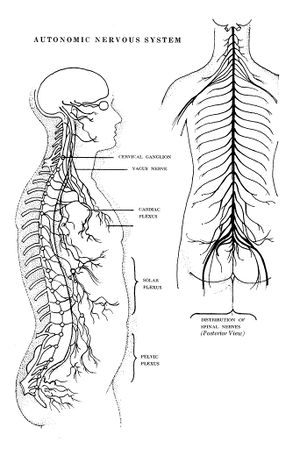Neuromyelitis Optica
Top Contributors - Kehinde Fatola, Reem Ramadan, Nikhil Benhur Abburi, Kim Jackson and Leana Louw
Introduction[edit | edit source]
Neuromyelitis optica, also called NMO or Devic's disease is a serious though rare autoimmune disease condition chiefly affecting the Central Nervous System (CNS). The myelin, an insulator of the CNS is the primary focus of the disease. Therefore disease specifically affects the optic nerve (CN II) and the spinal cord. The optic nerve is a paired nerve which convey visual impulses to the lateral geniculate nucleus of the brain. The spinal cord is composed of nervous tissue extending from the medulla oblongata (hindbrain) to the lumbar region of the spinal column. The disease thus causes blindness and paralysis as a result of the CNS parts it affects. [1] In 1894, Eugene Devic and his PhD student, Fernand Gault were able to to describe 16 patients whoso vision got impaired in either eyes. They were found to develop serious weakness of the extremities, sensory dysfunction and bladder control. They recognized the symptoms to be defects of the optic nerve and spinal cord. [2][3][4]
Epidemiology[edit | edit source]
Although, prevalence of NMO is yet to be established because it is unrecognized and confused with its differential diagnosis most especially multiple sclerosis. It is more prevalent in women than men. Patients usually have no family history and therefore it is a nonfamilial condition. [5]
Mechanism of Injury / Pathological Process[edit | edit source]
The mechanism of injury is the inflammation and demyelination of the optic nerve (optic neuritis) and the spinal cord (myelitis). [5]
Types[edit | edit source]
It is of two types. [1]
- Relapsing form: This is characterised by periodic flare-ups with some recovery and another surge later. 80% of affected patients are female.[5]
- Monophasic form, which involves a single attack that lasts a month or 2. Men and women get this type equally.
Clinical Presentation[edit | edit source]
The main symptoms of NMO are vision and spinal cord dysfunction.
Optic neuritis may present as; [5]
- Decreased visual acuity
- Visual field defects
- Colour blindness
Spinal cord dysfunction manifests in; [5][6]
- Muscle weakness
- Decreased sensation
- Incontinence
- Paraparesis
- Quadriparesis
- Vomiting
- Pains
Diagnostic Procedures[edit | edit source]
The following can be used to diagnose the condition; [5]
- Neurological examinations to examine movement, muscle strength, coordination, sensation, memory and thinking (cognitive) functions, and vision and speech. An ophthalmologist also may be involved in the examination.
- Magnetic Resonance Imaging (MRI) of the brain and spinal cord.
- Blood test / spinal tap (lumbar puncture) to test for antibodies which might indicate the presence of the disease.
- Stimuli response test to learn how well the brain responds to stimuli such as sounds, sights or touch.
The tests helps to find lesions or damaged areas in the nerves, spinal cord, optic nerve, brain or brainstem.
Differential Diagnosis[edit | edit source]
- Multiple sclerosis
- Guillain Barre Syndrome
- Disc herniation
- Transverse myelitis
- Parainfectious myelitis
- Tumour
- Epidural or subdural hematoma
- Epidural and/or paraspinal abscess
Medical Management / Interventions[edit | edit source]
The disease is not curable, however, proper management may ensure the patient live good quality life. Medical intervention may involve; [6]
- Intravenous corticosteroids
- Immunosuppressants
- Plasmapheresis
Physiotherapy Management[edit | edit source]
As stated earlier, no known cure has been found for the disease yet. However, Physiotherapy management is essential for possible future remission as interventions focuses on the clinical presentations which are most times physical disabilities. Physiotherapy interventions may include;
- Gait training
- Wheelchair training
- Pain reduction / management
- Transfers
- Reduce risk of pressure ulcers
- Aid control to spasticity
- Strengthening programme
- Stretching programme
References[edit | edit source]
- ↑ 1.0 1.1 Kowarik MC, Soltys J. Bennett JL. The Treatment of Neuromyelitis Optica. Journal of Neuro-Ophthalmology. 2014. 34 (1): 70–82
- ↑ Jarius S, Wildemann B. The history of neuromyelitis optica. Journal of Neuroinflammation. 2013.10 (1): 8.
- ↑ Devic E. Myélite subaiguë compliquée de névrite optique (Subacute myelitis complicated with optic neuritis). Bulletin of the Medical Library Association (in French).1894. 8: 1033.
- ↑ Murray TJ. Multiple Sclerosis: The History of a Disease . New York: Demos Medical Publishing. 2005
- ↑ 5.0 5.1 5.2 5.3 5.4 5.5 Barkhof F, Koeller KK (February 2020). 13 Demyelinating Diseases of the CNS (Brain and Spine) . In: Hodler J, Kubik-Huch RA, von Schulthess GK (eds.). Diseases of the Brain, Head and Neck, Spine 2020–2023: Diagnostic Imaging . IDKD Springer Series. Cham, Switzerland: Springer. pp. 165–176.
- ↑ 6.0 6.1 Wingerchuk DM, Lennon VA, Pittock SJ, Lucchinetti CF, Weinshenker BG. Revised Diagnostic Criteria for Neuromyelitis Optica. Journal of Neurology. 2006. 66 (10): 1485–9.







